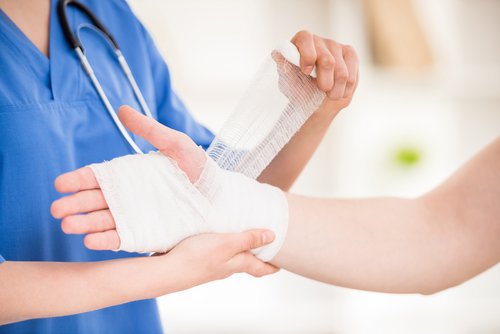
Our hands work tirelessly, serving as our primary tool for manipulating objects and engaging with the world around us. Those who work with their hands daily, including carpenters, mechanics, electricians, and other skilled professionals, understand this better than anyone else. Unfortunately, an accident commonly occurs in workplaces leading to injuries that can hinder an employee's ability to work during their treatment and recovery period.
AtBarrington Orthopedic Specialists, we are committed toworkers' compensation program and strive to educate workers about the potential risks they commonly face in the workplace. It is crucial to address these risks before they result in bone fractures or loss of function. Here, we discuss some of the most frequently occurring orthopedic hand injuries sustained at work.
Avulsions and Detachments
'Avulsion' refers to a medical condition where the outer layers of the skin are forcefully separated from the affected body part. This commonly occurs when a structure containing muscles and tendons is pulled in the opposite direction of the surrounding bone. Such injuries often expose underlying tissues, muscles, tendons, and even bones. Repairing these injuries, especially in the hands, can be challenging due to the potential for nerve damage. Flexor tendon injuries, flexor tendon injury, and broken bones are commonly associated with avulsions and detachments caused by accidents involving machinery. These incidents may arise from mechanical errors, user errors, or breaches of safety guidelines.
Crushed Hands
In certain workplaces, wrist injuries, tendon injuries, and ulnar collateral ligament damage are additional occupational hazards to your hands. Crushing accidents can occur when your hand gets trapped under a heavy object or when an object falls at high speeds. The impact can result in sudden and intense pain, followed by severe swelling. If your hand is fractured during the crush, you may even hear a cracking sound. It's important to note that the effects of these injuries may extend beyond the initial impact. You might experience symptoms like weakness, loss of motion, cramping, tingling, or numbness in your hand. Workers who regularly operate machinery or lift heavy objects, such as construction workers, factory workers, and delivery workers, are particularly at risk for these types of crushing injuries.
Fractured Fingers
Our fingers play a crucial role in our work, but they are also vulnerable to injury. Finger fractures can occur due to various reasons, such as accidents or misuse of power tools, and should not be overlooked. These fractures can have significant consequences, affecting not only the finger but also the entire hand. It is important to understand that along with the bones, there is a risk of nerve injury, damage to blood vessels, wrist fractures, and conditions like mallet finger resulting from acute injuries. Proper treatment and care are necessary to prevent permanent deficits and ensure the optimal function of your hand.
Sprains and Strains
Finally, one of the top reasons patients come to their orthopedist in Illinois complaining of a hand injury is due to a sprain or strain. Unlike the other types of hand injuries we’ve discussed here, sprains and strains in the hand can happen to just about any professional at work after enough repetitive motion with no breaks or exercises. If these injuries are left unaddressed long enough, they can even progress into something more severe that could require surgery to correct, such as carpal tunnel syndrome. The best way to avoid these injuries is to enact preventative measures, such as performing hand and wrist exercises, using proper posture while at work, and taking short breaks from repetitive motion at least every 3 hours.
One of the top reasons patients visit their orthopedist in Illinois is due to soft tissue injuries in the hand, such as sprains or strains. These types of injuries can occur in any profession, especially after repetitive motion without breaks or exercises. If left untreated, these injuries can progress into more severe conditions like carpal tunnel syndrome, potentially requiring surgery to correct. Other hand injuries, such as a wrist sprain, nerve injuries, and broken bones, can also result in loss of function. To prevent these injuries, it is important to implement preventative measures such as performing hand and wrist exercises, maintaining proper posture at work, and taking regular breaks from repetitive motions every 3 hours.
At Barrington Orthopedic Specialists, we specialize in hand surgery and the treatment of broken bones. Our dedicated workers' compensation department is readily available to assist you. You can reach them directly at(847) 285-4220 or conveniently request an appointment through our website at www.barringtonortho.com. Additionally, ourSchaumburg location offers a comprehensivework conditioning program designed to safely facilitate the return of injured workers to full duty. Trust us for exceptional care and expertise in hand surgery and broken bone treatment.
